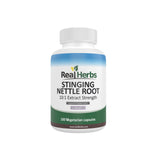Can You Eat Stinging Nettle Root?
Introduction
There is a growing interest in researching the potential health benefits of various botanicals in the realm of natural remedies and plant-based diets. Stinging nettle (Urtica dioica) is one such plant that has piqued the interest of health-conscious individuals. While the plant is well-known for its stinging hairs that cause irritation when touched, it has also been used in traditional medicine and culinary practices. This article will answer the question, "Can you eat stinging nettle root?" We'll look at the different aspects of eating stinging nettle root, such as its edible parts, potential health benefits, precautions, and expert opinions.
What Exactly Is Stinging Nettle?
Urtica dioica, also known as stinging nettle, is a perennial flowering plant native to Europe, Asia, and North America. It is distinguished by serrated leaves and tiny, hair-like structures that emit chemicals that cause a stinging sensation when touched. Despite its defensive mechanism, the leaves, stems, and roots of the stinging nettle plant have been used in traditional medicine and as a food source for centuries.
Stinging Nettle Edible Parts
The roots of the stinging nettle plant are among the most edible parts of the plant. The root is high in vitamins (such as vitamin C and B vitamins), minerals (such as iron, magnesium, and calcium), and bioactive compounds. These nutrients contribute to the potential health benefits of consuming stinging nettle root.
Stinging Nettle Root's Culinary Applications
Some cultures have traditionally used stinging nettle root in culinary preparations. It's been used in soups, teas, and even as an ingredient in home remedies. The root gives dishes a slightly earthy and nutty flavor, making it a unique addition to a variety of recipes.
Potential Health Advantages
More research is needed to establish definitive conclusions, but stinging nettle root appears to have several potential health benefits. Among the potential advantages are:
Anti-Inflammatory Effects: Stinging nettle root is thought to have anti-inflammatory properties, which could help with conditions like arthritis.
Urinary Tract Health: Stinging nettle root has been used in traditional herbal medicine to support urinary tract health, including treating symptoms of benign prostatic hyperplasia (BPH) in men.
Stinging nettle root contains antioxidants that may aid in the fight against oxidative stress in the body.
Considerations and Precautions
While stinging nettle root appears to have promise, there are some important precautions to take:
Allergic Reactions: Some people are allergic to stinging nettle and may experience skin irritation or allergic reactions if they come into contact with it or consume it.
Medication Interactions: Because stinging nettle root may interact with certain medications, such as blood thinners or diabetes medications, it is critical to consult a healthcare professional before incorporating it into your diet.
Proper Preparation: To avoid contaminants or adverse effects, stinging nettle root must be sourced and prepared correctly.
Opinions of Experts
Stinging nettle root, according to herbalists and nutrition experts, can be a valuable addition to a well-balanced diet. They do, however, emphasize the importance of moderation, individual variation, and seeking professional advice before making significant dietary changes.
Conclusion
Stinging nettle root stands out as a potential candidate for natural remedies and plant-based nutrition. Its historical use, combined with new research, suggests a variety of health benefits. However, stinging nettle root consumption should be approached with caution, taking into account potential allergies, medication interactions, and proper preparation. Before incorporating stinging nettle root into your diet, consult with your healthcare provider to ensure that it is compatible with your specific health needs.












